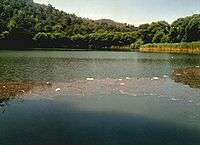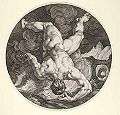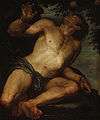Tantalus

Tantalus (Ancient Greek: Τάνταλος, Tántalos) was a Greek mythological figure, most famous for his eternal punishment in Tartarus. He was made to stand in a pool of water beneath a fruit tree with low branches, with the fruit ever eluding his grasp, and the water always receding before he could take a drink. He was the father of Pelops, Niobe and Broteas, and was a son of Zeus[1] and the nymph Plouto. Thus, like other heroes in Greek mythology such as Theseus and the Dioskouroi, Tantalus had both a hidden, divine parent and a mortal one.
Etymology
Plato in the Cratylus (395e) interprets Tantalos as ταλάντατος talantatos (acc. ταλάντατον in the original), "who has to bear much" from τάλας talas "wretched" (now the word talas is held to be inherited from Proto-Indo-European). R. S. P. Beekes has rejected an Indo-European interpretation.[2]
Historical background

There may have been a historical Tantalus – possibly the ruler of an Anatolian city named "Tantalís",[3] "the city of Tantalus", or of a city named "Sipylus".[4] Pausanias reports that there was a port under his name and a sepulchre of him "by no means obscure", in the same region.
Tantalus is referred to as "Phrygian", and sometimes even as "King of Phrygia",[5] although his city was located in the western extremity of Anatolia where Lydia was to emerge as a state before the beginning of the first millennium BC, and not in the traditional heartland of Phrygia, situated more inland. References to his son as "Pelops the Lydian" led some scholars to the conclusion that there would be good grounds for believing that he belonged to a primordial house of Lydia.
Other versions name his father as Tmolus, the name of a king of Lydia and, like Sipylus, of another mountain in ancient Lydia. The location of Tantalus' mortal mountain-fathers generally placed him in Lydia;[6] and more seldom in Phrygia[7] or Paphlagonia,[8] all in Asia Minor.
The identity of his wife is variously given: generally as Dione the daughter of Atlas;[9] the Pleiad Taygete, daughter of Atlas; Eurythemista, a daughter of the river-god Xanthus;[10] Euryanassa, daughter of Pactolus, another river-god of Anatolia, like the Xanthus;[11] Clytia, the child of Amphidamantes;[12] and Eupryto.[13] Tantalus, through Pelops, was the progenitor of the House of Atreus, which was named after his grandson Atreus. Tantalus was also the great-grandfather of Agamemnon and Menelaus.
The geographer Strabo, quoting earlier sources, states that the wealth of Tantalus was derived from the mines of Phrygia and Mount Sipylus. Near Mount Sipylus are archaeological features that have been associated with Tantalus and his house since Antiquity. Near Mount Yamanlar in İzmir (ancient Smyrna), where the Lake Karagöl (Lake Tantalus) associated with the accounts surrounding him is found, is a monument mentioned by Pausanias: the tholos "tomb of Tantalus" (later Christianized as "Saint Charalambos' tomb") and another one in Mount Sipylus,[14] and where a "throne of Pelops", an altar or bench carved in rock and conjecturally associated with his son is found. A more famous monument, a full-faced statue carved in rock mentioned by Pausanias is a statue of Cybele, said by Pausianias to have been carved by Broteas is in fact Hittite.
Further afield, based on a similarity between the names Tantalus and Hantili, it has been suggested that the name Tantalus may have derived from that of these two Hittite kings.[15]
Story of Tantalus
| Greek underworld |
|---|
| Residents |
| Geography |
| Famous Tartarus inmates |
| Visitors |
In mythology, Tantalus became one of the inhabitants of Tartarus, the deepest portion of the Underworld, reserved for the punishment of evildoers; there Odysseus saw him.[16] The association of Tantalus with the underworld is underscored by the names of his mother Plouto ("riches", as in gold and other mineral wealth), and grandmother, Chthonia ("earth").
Tantalus was initially known for having been welcomed to Zeus' table in Olympus, like Ixion. There he is said to have misbehaved and stolen ambrosia and nectar to bring it back to his people,[17] and revealed the secrets of the gods.[18]
Most famously, Tantalus offered up his son, Pelops, as a sacrifice. He cut Pelops up, boiled him, and served him up in a banquet for the gods. The gods became aware of the gruesome nature of the menu, so they did not touch the offering; only Demeter, distraught by the loss of her daughter, Persephone, absentmindedly ate part of the boy's shoulder. Clotho, one of the three Fates, ordered by Zeus, brought the boy to life again (she collected the parts of the body and boiled them in a sacred cauldron), rebuilding his shoulder with one wrought of ivory made by Hephaestus and presented by Demeter. The revived Pelops grew to be an extraordinarily handsome youth. The god Poseidon took him to Mount Olympus to teach him to use chariots. Later, Zeus threw Pelops out of Olympus due to his anger at Tantalus. The Greeks of classical times claimed to be horrified by Tantalus's doings; cannibalism and kinslaying were atrocities and taboo.
Tantalus's punishment for his act, now a proverbial term for temptation without satisfaction (the source of the English word tantalise[19]), was to stand in a pool of water beneath a fruit tree with low branches. Whenever he reached for the fruit, the branches raised his intended meal from his grasp. Whenever he bent down to get a drink, the water receded before he could get any. Over his head towers a threatening stone like the one that Sisyphus is punished to roll up a hill.[20] This fate has cursed him with eternal deprivation of nourishment.
In a different story, Tantalus was blamed for indirectly having stolen the dog made of gold created by Hephaestus (god of metals and smithing) for Rhea to watch over infant Zeus. Tantalus's friend Pandareus stole the dog and gave it to Tantalus for safekeeping. When asked later by Pandareus to return the dog, Tantalus denied that he had it, saying he "had neither seen nor heard of a golden dog." According to Robert Graves, this incident is why an enormous stone hangs over Tantalus's head. Others state that it was Tantalus who stole the dog, and gave it to Pandareus for safekeeping.
Tantalus was also the founder of the cursed House of Atreus in which variations on these atrocities continued. Misfortunes also occurred as a result of these acts, making the house the subject of many Greek tragedies. Tantalus's grave-sanctuary stood on Sipylus[21] but honours were paid him at Argos, where local tradition claimed to possess his bones.[22] In Lesbos, there was another hero-shrine in the small settlement of Polion and a mountain named after Tantalos.[23]
Tantalid family tree
Tantalus, son of Zeus and Plouto the nymph, and his wife Dione, had two sons Broteas and Pelops, and a daughter, Niobe.
- Broteas
Broteas's son was Tantalus II.
- Pelops
Pelops married Hippodameia and had the following children: Pittheus, Alcathous, Dias, Pleisthenes, Atreus, Thyestes, Copreus, Hippalcimus, Astydameia, Nicippe, and Eurydice. Atreus had a son named Agamemnon, whose son was Orestes and Thyestes had three sons: Tantalus III, Pleisthenes, and Aegisthus. Orestes became the ruler of all the Peloponessus and had a son named Tisamenus. Aegisthus had a son named Alete.
- Niobe
Niobe had fourteen children.
Other characters with the same name
in Greek mythology, there are two other characters named Tantalus—minor figures and descendants of the above Tantalus. Broteas is said to have had a son named Tantalus, who ruled over either the city of Pisa in the Peloponnesus or of Lydia in present-day Turkey. This Tantalus was the first husband of Clytemnestra. He was slain by Agamemnon, King of Mycenae, who made Clytemnestra his wife. The third Tantalus was a son of Thyestes, who was murdered by his uncle Atreus, and fed to his unsuspecting father.
Influence
- To tantalise originates from the story of Tantalus. When something is tantalising, it's desirable and always just out of reach.[24]
- The chemical element tantalum (symbol Ta, atomic number 73) is named after the mythological Tantalus; Ekeberg wrote "This metal I call tantalum … partly in allusion to its incapacity, when immersed in acid, to absorb any and be saturated.".
- A Tantalus is a type of drinks decanter stand in which the bottle stoppers are clamped down by a locked bar, as a means of preventing servants from stealing the master's liquor. The decanters are clearly visible but the liquor is out of reach.
- In naval history, an early 20th-century British Merchant Navy freight ship SS Tantalus and a United States Navy landing craft repair ship of the World War II (USS Tantalus (ARL-27)) were named after Tantalus.
- Lucian's satire Dialogues of the Dead, where Menippus travels into the underworld speaking to various shades, includes a short conversation between Menippus and Tantalus, concerning the punishment of the latter.[25]
- Emily Dickinson's poem "'Heaven'—is what I cannot reach!" makes allusions to Tantalus in lines in the first stanza, especially lines two through four: "'Heaven'—is what I cannot reach!/The Apple on the Tree—/Provided it do hopeless—hang—/That—'Heaven' is—to Me!"[26]
- Susanna Clarke's novel Jonathan Strange and Mr. Norrell references Tantalus: "This wine is one of the vintages of Hell – but do not allow yourself to be dissuaded from tasting it upon that account! I dare say you have heard of Tantalus? The wicked king who baked his little son in a pie and ate him? He has been condemned to stand up to his chin in a pool of water he cannot drink, beneath a vine laden with grapes he cannot eat. This wine is made from those grapes. And, since the vine was planted there for the sole purpose of tormenting Tantalus, you may be sure the grapes have an excellent flavour and aroma – and so does the wine."[27]
- Tantalus is featured as a minor antagonist in Rick Riordan's fantasy novel The Sea of Monsters, in which he is brought back from the Underworld and serves as a temporary replacement for the centaur Chiron, who is used as a scapegoat for the main antagonist Kronos and his servant Luke Castellan. Upon his introduction, Tantalus becomes a tyrant, ruling over the demigods at Camp Half-Blood.
- The tantulus field is a device in Star Trek The Original Series that allows users to monitor, transport to or eliminate a person from a location within its range by simply pressing a button. It appeared in The Original Series episode "Mirror, Mirror".
- Also in the Star Trek Original Series episode, Dagger of the Mind, "Tantalus V" is the name of a colony for treatment of the criminally insane. Unfortunately, the Colony leader, Dr. Tristan Adams is insane himself, torturing his patients with a "neural neutralizer". Adams torture usually involved placing thoughts of unrequited want or desire in the minds of his patients/victims.
- The Tantalus Theater Troupe is a bandit group to which the main protagonist, Zidane Tribal, belongs in the SquareSoft video game, Final Fantasy IX.
Tantalus in art
 Engraving by Hendrik Goltzius and C. Cornelius (1588)
Engraving by Hendrik Goltzius and C. Cornelius (1588) Oil painting by Gioacchino Assereto (circa 1640s)
Oil painting by Gioacchino Assereto (circa 1640s) Etching by Francisco Goya (1797)
Etching by Francisco Goya (1797)
See also
Notes
- ↑ Euripides, Orestes.
- ↑ R. S. P. Beekes, Etymological Dictionary of Greek, Brill, 2009, p. 1449.
- ↑ George Perrot (2007). History of Art in Phrygia, Lydia, Caria And Lycia (in French and English). Marton Press. p. 62. ISBN 978-1-4067-0883-7.
- ↑ This refers to Mount Sipylus, at the foot of which his city was located and whose ruins were reported to be still visible in the beginning of the Common Era, although few traces remain today. See Sir James Frazer, Pausanias, and other Greek sketches (later retitled Pausanias's Description of Greece.
- ↑ Thomas Bulfinch. Bulfinch's Mythology ISBN 1-4191-1109-4, 1855–2004. Kessinger Publishing Company.
- ↑ Pindar, Olympian Ode 1.24–38, 9.9; Strabo 1.3.17; Pausanias 5.1.6, 9.5.7.
- ↑ Strabo, xii.8.21
- ↑ Diodorus Siculus, 4.74.
- ↑ Hyginus, Fabulae, 82 & 83
- ↑ Scholia on Euripides, Orestes, 11
- ↑ Tzetzes on Lycophron, 52
- ↑ Graves 1960, section 108
- ↑ mythindex.com, "Tantalus".
- ↑ Various sites called the "tomb of Tantalus" have been shown to travellers since the time of Pausanias.
- ↑ M. L. West (1999). The East Face of Helicon: West Asiatic Elements in Greek Poetry and Myth. Oxford University Press. p. 475. ISBN 978-0-19-815221-7.
- ↑ Odyssey xi.582-92; Tantalus' transgressions are not mentioned; they must already have been well known to Homer's late-8th-century hearers.
- ↑ Pindar, First Olympian Ode.
- ↑ Euripides, Orestes, 10.
- ↑ Dictionary.com – tantalize
- ↑ This detail was added to the myth by the painter Polygnotus, according to Pausanias (10.31.12), noted in Kerenyi 1959:61.
- ↑ Pausanias, 2.22.3.
- ↑ Pausanias, 2.22.2.
- ↑ Stephen of Byzantium, noted by Kerenyi 1959:57, note 218.
- ↑ Acme's Cup of Tantalus
- ↑ http://www.theoi.com/Text/LucianDialoguesDead1.html#7
- ↑ Meyer, Michael "Poetry: An Introduction" sixth edition. page 326
- ↑ Clarke, Susanna "Jonathan Strange and Mr. Norell" paperback, Bloomsbury Publishing ISBN 1-58234-416-7 (page 500)
References
- Bibliotheca III, v, 6
- Apollodorus, Epitome II,1–3
- Encyclopaedia Britannica 1911: "Tantalus"
- Gantz, Timothy (1993). Early Greek Myth. Baltimore: Johns Hopkins University Press.
- Graves, Robert (1960, 1962). The Greek Myths. Check date values in:
|date=(help) - Grimal, Pierre, The Dictionary of Classical Mythology, Wiley-Blackwell, 1996, ISBN 978-0-631-20102-1. "Tantalus" p. 431
- Hyginus, Fabulae 82
- Kerenyi, Karl (1959). The Heroes of the Greeks. New York/London: Thames and Hudson.pp 57–61 et passim
- Ovid, Metamorphoses IV, 458-9; VI, 172- 76 & 403-11.
- Smith, William; Dictionary of Greek and Roman Biography and Mythology, London (1873). "Ta'ntalus"
External links
-
 Media related to Tantalus at Wikimedia Commons
Media related to Tantalus at Wikimedia Commons